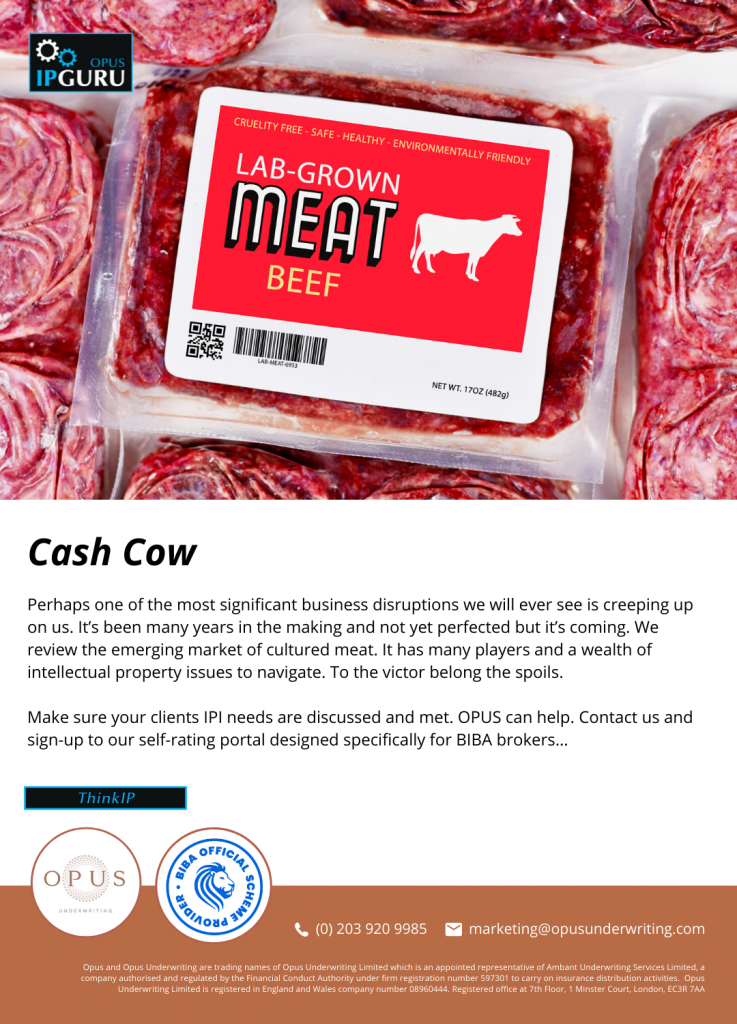Bull market
So much at steak…
Shut your eyes. Nice and tight. Now think of a world where farms are vertical, over 20 floors or more, and thousands of acres of grazing land is set to more efficient plant-based food production or, better still, re-wilding. A world where animals are not raised and slaughtered for meat and some vegetarians are persuaded to eat burgers, their principles no longer offended. You have just entered the world of cultured meat or cellular agriculture. Dare we imagine such a place? Indeed, we may, it’s emerging fast and with so much at stake the intellectual property issues it touches are as enormous as the potential market. With the common thread of environmental protection, the disruption to the meat market could, by comparison, dwarf the current impact of electric cars on the automotive industry. Time to open those eyes for a closer look.
The moral maze
The starting point from an IP perspective is simple enough, in theory: naturally occurring biological subject matter whether plants or animals including their cells and cell lines are not patentable. The law in the U.S. and Europe introduces a ‘morality backstop’ if you like, to prevent immoral inventions and save humanity from its own curiosity (I added that last bit – but you get the gist). So, mutant animals are probably unlawful given the legal test must balance:
“…the suffering of animals and …risks to the environment” with its “…usefulness to mankind”
However, here’s the rub in favour of experimental food science; stem cells and cell lines that have been genetically engineered are considered patentable since they are not products of nature. The door swings open for petri-dish beef.
Cell line recipes
To grow a steak in a laboratory you need bio building blocks and some kit. Specifically, cells that divide and grow, food to stimulate that growth, a bioreactor (vessel to grow it in) and some bio-chemical ‘scaffolding’ to give the end-product recognisable structure, slime being a poor and unappetising substitute for a nice piece of beef. Where you get these components, the secrecy that surrounds them and the bio-chemical engineering involved is truly fascinating.
Cell lines are critical. They are the most basic scientific tool required. Abundant in the biomedical industry for many years but for cultured meat they are scarce and closely guarded. The scale of other cell lines available is worth a mention. In Manassas Virginia U.S., the freezers of the American Type Culture Collection (ATCC), contain 4,000 cell lines from 150 species. For fifty years these have been used to develop drugs and vaccines. Some cell lines, tweaked by man, defy the laws of nature and are immortal having escaped the Hayflick limit (look it up) – duplicating endlessly to supply man’s scientific needs. One such cell line taken from a woman dying of cervical cancer in 1951 has helped develop world-changing vaccines and from that initial “HeLa” culture more than 50 million tonnes of her cells have been grown and harvested in the last 70 years. An awesome fact.
Big picture
If the enormity of the potential consequences to society that is cellular immortality and the scale of this industry is news to you, perhaps it’s time to move on from reality TV shows and consume less Made in Chelsea and more Made in Porton Down.
The problem for cultured beef production is getting started. Cell lines for this species are rare. The science in this field isn’t shared. Cultured beef producers are keeping their cards and cell lines close to their chests. Even a cell line open banking scheme that ensures intellectual property protection, is hardly used. It is said its only deposit to date is from a European Sea Bass. Not much use to lab’ meat farmers. But you can see why. The first to crack the problem and rival traditional big beef production with a manufactured competitively- costed alternative, deliverable at scale, will hit paydirt.
Fork in the road
We’ve come a long way since the first patent was filed for the concept of laboratory grown meat by Jon F. Vein in the U.S. in 1991. And whilst cultured meat has been successfully grown and eaten, it’s currently around 100 to 10,000 times more expensive than conventional meat. It’s all a bit niche, and so the environmentally ruinous mega-farms continue with their methane-emitting bovine armies, eating through the forests of the world.
But for how long? Industry estimates suggest around 40 companies are currently vying to bring cultured meat to our tables. Veritable ‘red meat’ to the venture capitalists currently circling those most likely to succeed. Patent lawyers are rubbing their hands.
Postscript
Many writers on this subject quote the following:
“Fifty years hence, we shall escape the absurdity of growing a whole chicken in order to eat the breast or wing by growing these parts separately under a suitable medium.”
Winston Churchill, 1931
Some say Churchill’s Fifty Years Hence is a work of science fiction. Some say it’s a serious essay in ‘futurology’. In truth it’s a warning that we can’t take the past as a reliable guide to the future. Science will accelerate change and an historian’s obsession with past patterns to determine the future must be discarded. Could Churchill have been telling us back in the 1930’s, that real progress is driven by science and the intellectual property that lies within?
For sure, cellular meat production is no longer a prediction. It’s a reality waiting for its mass market to happen.
Murray Fairclough
Development Underwriter
OPUS Underwriting Limited
+44 (0) 203 920 9985
underwriting@opusunderwriting.com
Written and researched by Ben Fairclough








